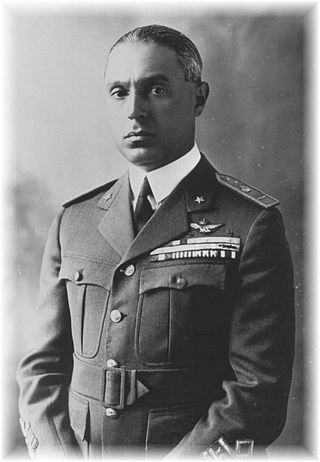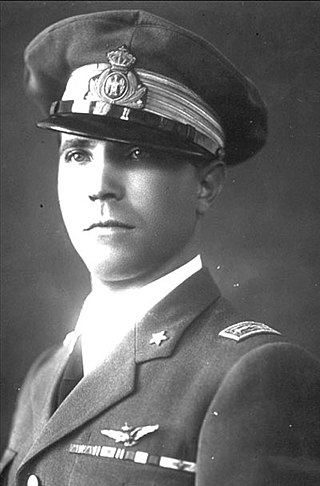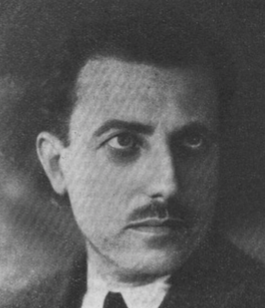
The Polizia di Stato is one of the national police forces of Italy. Alongside the Carabinieri, it is the main police force for providing police duties, primarily to cities and large towns, and with its child agencies it is also responsible for highway patrol (autostrade), railways (ferrovie), airports (aeroporti), customs as well as certain waterways, and assisting the local police forces.

Francesco de Pinedo was a famous Italian aviator. A Regia Marina officer who transferred to the Regia Aeronautica, he was an advocate of the seaplane and is best known for his long-range flying boat flights in the 1920s that demonstrated the feasibility of global air travel.

The Ministry of Defence is the government body of the Italian Republic responsible for military and civil defence matters and managing the Italian Armed Forces. It is led by the Italian Minister of Defence, a position occupied by Guido Crosetto since October 2022.

Alessandro Guidoni served as a general in the Regia Aeronautica. Guidonia Montecelio, the small town and comune where he died while testing a new parachute, was named after him in 1937.

Amedeo Mecozzi was an Italian fighter ace of World War I, a general of the Italian Regia Aeronautica and a military theorist credited as the founding father of the "Attack air force" doctrine, which made him a strong opponent to general Giulio Douhet's theories.

Antonio Lippi was an Italian aviator. He participated in the transatlantic flight organized by Italo Balbo and was awarded the Gold Medal of Aeronautic Valor of the Regia Aeronautica.

Arturo Ferrarin was an Italian pioneer aviator. His exploits included winning the "Rome-Tokyo Raid" air race in 1920 and a non-stop flight from Italy to Brazil in 1928 with fellow aviator Carlo Del Prete. The latter flight set the world distance record for a non-stop flight. Ferrarin, who was born in Thiene and was a decorated veteran of the Italian Royal Air Force during World War I, died in a plane crash at Guidonia Montecelio in 1941.
The article provides an overview of the entire chain of command and organization of the Italian Air Force as of 1 January 2018 and includes all currently active units. The Armed Forces of Italy are under the command of the Italian Supreme Defense Council, presided over by the President of the Italian Republic. The Italian Air Force is commanded by the Chief of the Air Force General Staff or "Capo di Stato Maggiore dell’Aeronautica Militare" in Rome.

The Minister of Aeronautics of Italy, was the minister responsible for the Ministry of Aeronautics, which oversaw both military aviation — the Regia Aeronautica until 1946, then the Aeronautica Militare until 1947 — and civil aviation. The position was created in 1925 during the Mussolini Cabinet and was abolished in 1947 with the creation of the position of Minister of Defence.
The following is the structure of the Italian Navy as of June 2020. It is considered a multiregional and a blue-water navy.

Aldo Pellegrini was an Italian Air Force general during World War II.

Attilio Biseo was an Italian aviator, powerboat racer, Air Force general during World War II, and the personal pilot of Benito Mussolini during the 1930s.

Gennaro Tedeschini Lalli was an Italian Air Force general during World War II. He was in command of the Air Force in Italian East Africa from 1937 to 1939, in Sicily in 1940, and in Northern Italy from 1941 to 1943.

The Ministry of the Navy was a ministry of the Kingdom of Italy from 1861 to 1946 and of the Italian Republic from 1946 to 1947. Under the Kingdom of Italy, it oversaw the Regia Marina, while under the Italian Republic, when its name became Ministero della marina militare, it oversaw the Marina Militare. The ministry was abolished in 1947, when it merged with the Ministry of Aeronautics and the Ministry of War to form the Ministry of Defence.

Sabato Martelli Castaldi was an Italian Air Force general and a member of the Italian Resistance during World War II. He was executed during the Ardeatine massacre.

Giuseppe Valle was an Italian Air Force general during the interwar period, Chief of Staff of the Regia Aeronautica from 1928 to 1939 and State Undersecretary for the Air Force from 1933 to 1939. He was also a member of the Chamber of Fasces and Corporations.
Egisto Perino was an Italian Air Force general during World War II.
Ruggero Bonomi was an Italian Air Force general during the Spanish Civil War and World War II. He was deputy commander of the Corpo Aereo Italiano and commander of the Auxiliary Naval Air Force; after the Armistice of Cassibile he became the last State Undersecretary for the Air Force of the Italian Social Republic.

Manlio Molfese was an Italian Air Force officer during World War I and World War II. During the interwar period he held various management roles in the field of civil aviation. After the Armistice of Cassibile he became State Undersecretary for the Air Force of the Italian Social Republic.

The Ministry of War was a ministry of the Kingdom of Italy from 1861 to 1946 and of the Italian Republic from 1946 to 1947. Under the Kingdom of Italy, it oversaw the Royal Army, while under the Italian Republic it oversaw the Italian Army. It was abolished in 1947, when it merged with the Ministry of Aeronautics and the Ministry of the Navy to form the Ministry of Defence.
















